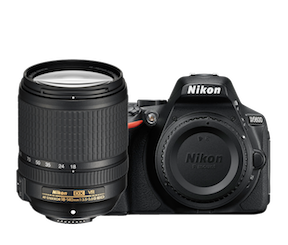
| Back to January 23 | January 24, 2018 | On to January 25 |
I bought a new camera last year to get back into photography. I still have the Nikon FM and FE I bought in the 1970s, along with a nice selection of lenses. I wanted a camera body that would allow me to use my existing lenses and also bring me up to the age of digital photography. I've had a number of fixed-lens digital cameras (and iPhone cameras) but this was to be my return to the SLR days.
I've always liked the single lens reflex camera (SLR). The combination of optics and mechanics were very satisfying. The precision of good lenses and the way they focused just felt good. The action of cocking the shutter, feeling the springs get tensioned and film advancing all in one smooth throw of a perfectly crafted film advance lever were a rewarding moment in itself. The sound of the mirror moving up, focal plane shutter moving at my pre-determined speed and lens diaphragm closing to allow in just enough light, shutter closing at such a precise moment, all in perfect unity, was a combination that made me happy. Optics plus mechanics in a device I could understand and use. The FM was all mechanical, other than a rudimentary exposure meter. The FE had electronic exposure and metering but those cameras were still very mechanical devices. I have the motor-drive for them and when I rattle off five or six shots in a row, it produces a very rewarding sound.
I've had some sort of digital camera since 1997. My first was a Casio QV10a that produced images at 640x480 pixels. It was magic and allowed me begin putting picture on my web site.
The Casio was replaced with one Kodak camera, then another. I liked the color quality the Kodaks gave me, much like I liked Kodachrome over Ektachrome in the film days. Other cameras, both still and video came and went but I never wanted to spend the money on a Digital SLR. I was overwhelmed with the choices and watched them get better and better each year.
Last year, in preparing for retirement, I took a close look at what Nikon was offering, figuring I could continue to use my Nikkor lenses. I knew I wouldn't be going the 'professional' route and was willing to use a crop sensor vs full frame 35mm equivalent. I did some research and bought a Nikon D5600 with the 18-140 DX lens.

I've been really happy with this camera. See PBMan Review on the Nikon site.
It's described as an "Advanced Amateur" camera and I think that's correct. Many of the mechanisms have been replaced by electronics but it still has the nice feel in my hands that my Nikon FE did. It still has a mirror and still makes that rewarding, 'kerplunk' as the it moves out of the way and back. Not quite as heavy as the metal cameras and the mechanical timer and film advance have made way for electronics but the carbon-fibre, features and capabilities are far beyond my needs.
I'm still learning some of the capabilities for one of my purchase criteria was that I could still take complete control of the shutter speed, aperture, focus and ISO. This is very relevant with my older lenses. So far, some of my best experience has been to set the camera to a fixed ISO and use the old "1/ASA at F16" rule. I still have that burned in my mind - f5.6 for heavy overcast, f8 for cloudy, f-11 for slight overcast, f-16 for full sun. I see there are variations of the description but it comes down to understanding the light.
Yesterday I got my third fully automatic lens for this camera. I bought it with a 18-140, which gives me a great range and lets me walk around capturing wide scenics, to telephotos and portaits. I chose to get that as my kit lens over the more common two lens option.
My first tryout of the D5600 was a kit from Costco that included the camera, a 18-55 and a 55-200 zoom lenses. On my first trip out with them I found I was swapping lenses too often so I opted for the 18-140 when I bought the camera from Adorama. Then I bought a 55-300 for when I wanted to shoot distances. That was a great combination in itself.
As I learned the camera controls and settings I started using my older prime lenses and I've been happy to use my 35mm f2 as a more compact combination. I purchased a refurbished 50mm 1.8G from Nikon that doesn't have autofocusing but does work with my older camera bodies. A nice add on but a bit of a compromise. If I had to focus myself, I might as well stick with the older lens.
Yesterday I received a 18-55 DX lens, another Nikon refurb for less than $100. This is the same lens that was on the Costco kit, compact and fully automatic. This gives me three DX lenses - A walkaround, a compact and a telephoto. And I still have the primes.
I spent a bit of time today doing compares between the DX lenses and the older Nikkors. It's a good way for me to see the difference and also get more experience with exposure and focus on the new camera.
My Nikon D5600 Kit- DX zooms: 18-55, 18-140, 55-300. 50mm f1.8G. Legacy primes: 24mm f2.8, 35mm f2, 55mm micro f3.5, 135 f2.8. Extension tubes.
Big Sur Looking South - January 2009
This was taken in 2009 with a Kodak Z710 camera. I liked the camera because it's Zeiss zoom lens was flexible and compact. It wasn't high resolution but it was sharp enough and was easy to carry around.
| Back to January 23 | rudy@rugebregt.com | On to January 25 |